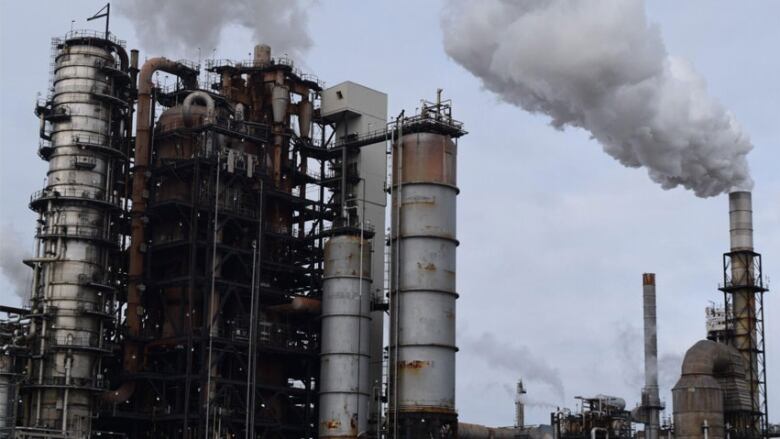Health branch investigates air quality complaints after Irving refinery releases dust
Risk assessment being conducted after fine particulate released from Saint John refinery

The Department of Health is investigating air quality complaints after the Irving Oil refinery in east Saint John released fine particulate on Sunday, leaving some area homes and vehicles covered in a white dust.
"The Department of Health is aware of complaints regarding a change in air quality in the Saint John region over the long weekend," Dr. Isaac Sobol, the local medical officer of health, said in an emailed statement to CBC News on Thursday afternoon.
"At this time the local health protection branch is gathering information and performing a risk assessment."
The statement does not indicate how many people complained or to whom. It's also unclear how long the risk assessment might take.
Department officials could not immediately be reached to clarify.
- East Saint John residents worry about 'particulate' released from Irving refinery
- Irving Oil not charged after refinery problems
The Department of Environment is also investigating the incident, described by a New Brunswick Lung Association official as a "serious threat to lung health."
Fine particulate "can be inhaled deeply into the lungs and damage lung tissue," the association's director of health Barbara Walls has said.
Irving Oil has not responded to a request for an interview.
Some residents worried
But in an apology letter distributed to affected residents, the company said there was a"technical issueduring the start-up of the refinery'sfluidizedcatalytic cracking unit (FCCU) from the maintenance turnaround."
"As a result, we had an impact to some areas inthe neighbouring communities with the distribution of fine particulate. We sincerely apologize."
The letter was left in mailboxes, along with $30 in gift certificates for Irving gas stations.

Some Red Head area residents expressed concerns to CBCNews on Wednesday about not knowing what was in the particulate or the possible health impact.
The Department of Environment defines fine particulate as tiny airborne specks, measuring 2.5 microns in diameter or less,made up of solid or liquid matter, such as dust and soot. It is generated by natural sources, such as wind-blown dust and forest fires, and through fuel burning, especially fossil fuels and wood
Fine particulate "causes and aggravates a variety of human breathing ailments, such as asthma, lung disease and bronchitis," according to the department. It also contributes to haze.
Contains heavy metals
Clean air activist Gordon Dalzell,who used to sit on the company'scommunity liaison committee, said fine particulate is "certainly a concern" not just during such "upset conditions," but every day during regular emissions.
Particulatetypically contains heavy metals, he said.
It can just infiltrate into the body basically. The body does not have any way to defenditself.- Gordon Dalzell, clean air activist
And unlike the larger, coarser type of particulate, known as total suspended particulate, fine particulate is "very, very fine almost smaller than the human hair,"said Dalzell.
"It can just infiltrate into the body basically. The body does not have any way to defenditself from this fine particulate matter. It goes directly into the lungs."
Dalzellestimates 25,000 to 30,000 people live in the five communities surrounding the Irving Oil refinery, the largest petroleum refinery in Canada. He is among them.

"We haven't seen a lot of examples of these types of incidents lately. We used to have them more frequently in the past," said Dalzell, including three back-to-back releases in August 2010.
"When they do happen, they are a concern and they shouldn't happen," he said. "But at least [Irving Oil] took responsibility for it and they, you know, acknowledged it so that's positive."
The particulate released during previous incidents at the refinery was "fairly large" in the range of 28 to 32 microns, according to spokespersonMarcAndrChiasson.
Those incidents were deemed"more of a nuisance issue," he said.
The departmentis expecting a report from Irving Oil on the latest incident this week, said Chiasson.
Seeks higher standards
Saint John is below the national standard for fine particulate matter, according to the 2015 Air Quality Monitoring Results report, which was just released last month by the Department of Environment.
But Dalzell contends "it wouldn't take much for these standards to be exceeded," and he thinks the bar should be higher to better protect the public.
There are two types of Canadian Ambient Air Quality Standards for particulate matter. The annual metric, which is the annual average, and daily metric, which is based on the daily average of the 98th percentile day one of the poorest air quality days of the year.
The annual metric standard is 10 micrograms per cubic metre. The provincial air quality monitoring station on Castle Street, about five kilometres west of the Irving Oil refinery, had the highest level at 7.4.
The other Saint John readings were from Forest Hills, 6.4, the west side, 6.0, and Champlain Heights, 5.9.
The daily metric standard is 28 micrograms per cubic metre. Castle Street had the highest level again at 20, followed by Forest Hills, 18, and Champlain Heights and the west side, which were tied at 15.
With files from Joseph Tunney












_(720p).jpg)


 OFFICIAL HD MUSIC VIDEO.jpg)
.jpg)



























































































